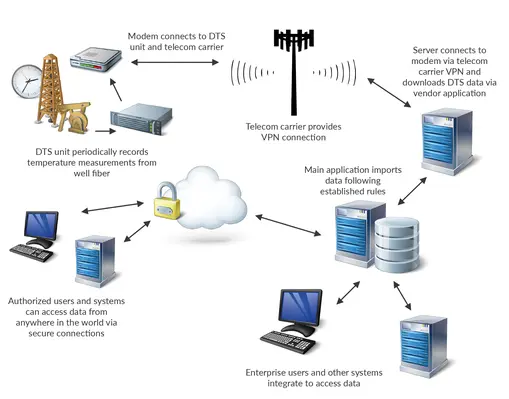Recovering downhole distributed temperature sensing (DTS) data, accurately processing it and making it available for use anywhere within a global enterprise infrastructure, can be challenging for wells located in remote locations, according to Andy Nelson, senior software engineer with Tendeka
Deploying Tendeka’s FloQuest modelling and analysis software can accurately define, model and match data from sensors across the sandface to the wellhead. This uses proprietary algorithms and intuitive interfaces to seamlessly integrate multiple data sources into clear visual outputs.
Coupled with Tendeka’s DataServer, it was first installed in a multiphase development across 12 remote coal seam gas wells in the Surat Basin, Australia for a major producer.
Trusted power and connectivity
Prior to installation of DataServer, previous units deployed in the field provided limited connectivity options. The only method provided by the DTS vendor was via a proprietary Windows desktop application. Typical collection required someone physically visiting the site and downloading the data via the application to a laptop computer and then returning that data to the office domain at some later time.
To provide a working solution, each well was equipped with either local gas-powered electrical generators or solar-powered units capable of running the DTS units and modem for extended periods without human intervention. In the case of solar-generation, throughout the hours of darkness and times of inclement weather.
Tendeka personnel connected each Sensornet DTS unit to a GPRS modem. Using the telecom carrier’s infrastructure, a hardware-based virtual private network (VPN) was established between the modem and centralised servers, thus securing the remote connectivity solution from outside intrusion. The modem was then connected directly to the DTS unit via a serial communication port. A tunnel capable of linking a COM port on the DTS unit over potentially any distance to the server in the data-centre was also established.
Fast and efficient data recovery
Having set up the physical connection, the next task was to recover the data. DataServer software was set up to continuously poll for new DTS measurements as the data became available. Once recorded, the measurements would be retrieved from the DTS instrument and copied to the server.
A second server operating in the data-centre was installed with software responsible for managing the DTS data. This software is alerted to new DTS measurements being saved and then proceeds to import those measurements. A workflow process of validating the data was the first step in the import process.
Each file is opened and checked against pre-configured rules to determine if the data is coming from the expected well site. For example, the DTS measurement data contains details about the well, such as a name or unique identifier, which must be validated before data can be imported.
During import, any errors or data discrepancies are flagged in an alerting system to a human operator so that the data can be manually checked. The alerting system also notifies operators if the DTS unit appears to be offline, if the data coming back from the instrument is corrupt, or if the modem communications are down.

Safe and secure communications
Having imported the data, the application manages data security and access to both human operators, using the FloQuest analysis and modelling software, and automated systems. Furthermore, the system has an application programming interface (API) that offers a representational state transfer (REST) interface to allow third-party systems, with the appropriate authorisation, access to the data, analysed results and alert status. Figure 1 shows the architectural data flow.
The results from this solution have been impressive and, to date, multiple solutions with a similar or identical architecture have been deployed. The initial solution monitored 12 wells in Australia but has subsequently been scaled to monitor more than 100 wells with another customer in South Asia utilising the same solution and similar infrastructure. Each deployment changes depending upon the infrastructure needs of the well. Subsequent projects have been deployed using existing DTS vendors for the instrument boxes.









